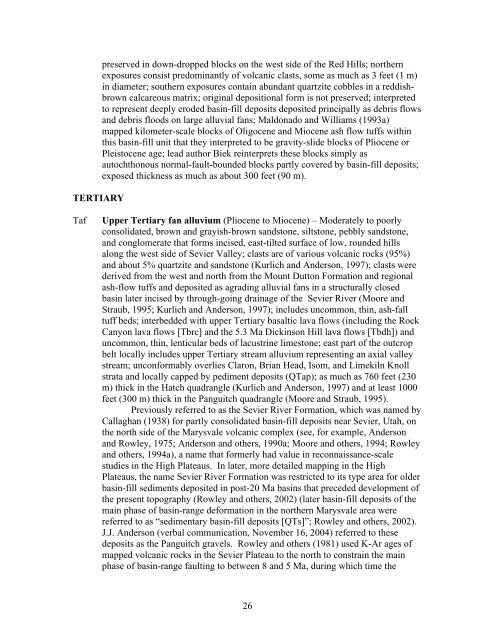Interim Geologic Map of the West Part of - Utah Geological Survey
Interim Geologic Map of the West Part of - Utah Geological Survey
Interim Geologic Map of the West Part of - Utah Geological Survey
You also want an ePaper? Increase the reach of your titles
YUMPU automatically turns print PDFs into web optimized ePapers that Google loves.
TERTIARYpreserved in down-dropped blocks on <strong>the</strong> west side <strong>of</strong> <strong>the</strong> Red Hills; nor<strong>the</strong>rnexposures consist predominantly <strong>of</strong> volcanic clasts, some as much as 3 feet (1 m)in diameter; sou<strong>the</strong>rn exposures contain abundant quartzite cobbles in a reddishbrowncalcareous matrix; original depositional form is not preserved; interpretedto represent deeply eroded basin-fill deposits deposited principally as debris flowsand debris floods on large alluvial fans; Maldonado and Williams (1993a)mapped kilometer-scale blocks <strong>of</strong> Oligocene and Miocene ash flow tuffs withinthis basin-fill unit that <strong>the</strong>y interpreted to be gravity-slide blocks <strong>of</strong> Pliocene orPleistocene age; lead author Biek reinterprets <strong>the</strong>se blocks simply asautochthonous normal-fault-bounded blocks partly covered by basin-fill deposits;exposed thickness as much as about 300 feet (90 m).TafUpper Tertiary fan alluvium (Pliocene to Miocene) – Moderately to poorlyconsolidated, brown and grayish-brown sandstone, siltstone, pebbly sandstone,and conglomerate that forms incised, east-tilted surface <strong>of</strong> low, rounded hillsalong <strong>the</strong> west side <strong>of</strong> Sevier Valley; clasts are <strong>of</strong> various volcanic rocks (95%)and about 5% quartzite and sandstone (Kurlich and Anderson, 1997); clasts werederived from <strong>the</strong> west and north from <strong>the</strong> Mount Dutton Formation and regionalash-flow tuffs and deposited as agrading alluvial fans in a structurally closedbasin later incised by through-going drainage <strong>of</strong> <strong>the</strong> Sevier River (Moore andStraub, 1995; Kurlich and Anderson, 1997); includes uncommon, thin, ash-falltuff beds; interbedded with upper Tertiary basaltic lava flows (including <strong>the</strong> RockCanyon lava flows [Tbrc] and <strong>the</strong> 5.3 Ma Dickinson Hill lava flows [Tbdh]) anduncommon, thin, lenticular beds <strong>of</strong> lacustrine limestone; east part <strong>of</strong> <strong>the</strong> outcropbelt locally includes upper Tertiary stream alluvium representing an axial valleystream; unconformably overlies Claron, Brian Head, Isom, and Limekiln Knollstrata and locally capped by pediment deposits (QTap); as much as 760 feet (230m) thick in <strong>the</strong> Hatch quadrangle (Kurlich and Anderson, 1997) and at least 1000feet (300 m) thick in <strong>the</strong> Panguitch quadrangle (Moore and Straub, 1995).Previously referred to as <strong>the</strong> Sevier River Formation, which was named byCallaghan (1938) for partly consolidated basin-fill deposits near Sevier, <strong>Utah</strong>, on<strong>the</strong> north side <strong>of</strong> <strong>the</strong> Marysvale volcanic complex (see, for example, Andersonand Rowley, 1975; Anderson and o<strong>the</strong>rs, 1990a; Moore and o<strong>the</strong>rs, 1994; Rowleyand o<strong>the</strong>rs, 1994a), a name that formerly had value in reconnaissance-scalestudies in <strong>the</strong> High Plateaus. In later, more detailed mapping in <strong>the</strong> HighPlateaus, <strong>the</strong> name Sevier River Formation was restricted to its type area for olderbasin-fill sediments deposited in post-20 Ma basins that preceded development <strong>of</strong><strong>the</strong> present topography (Rowley and o<strong>the</strong>rs, 2002) (later basin-fill deposits <strong>of</strong> <strong>the</strong>main phase <strong>of</strong> basin-range deformation in <strong>the</strong> nor<strong>the</strong>rn Marysvale area werereferred to as “sedimentary basin-fill deposits [QTs]”; Rowley and o<strong>the</strong>rs, 2002).J.J. Anderson (verbal communication, November 16, 2004) referred to <strong>the</strong>sedeposits as <strong>the</strong> Panguitch gravels. Rowley and o<strong>the</strong>rs (1981) used K-Ar ages <strong>of</strong>mapped volcanic rocks in <strong>the</strong> Sevier Plateau to <strong>the</strong> north to constrain <strong>the</strong> mainphase <strong>of</strong> basin-range faulting to between 8 and 5 Ma, during which time <strong>the</strong>26
















